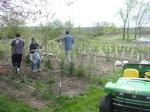Posted on Tuesday, April 27, 2010
As a lead-in to Earth Day 2010, Dr. Helen Boylan, associate professor of chemistry, brought the Chem Club to the Field Station April 20 to practice practical chemistry. Students dug and transplanted nine Red Osier dogwoods from the nursery to a wetland in the Microforest.
This dogwood species, Cornus sericea, is native to our area and to a vast array of habitats from Alaska to Virginia. It grows well at lower pH values and tolerates a soggy environment. It avoids freezing injury caused when ice forms within living cells by having freezable water frozen outside the cells. The factors that seem to affect cold acclimation are low temperatures, short days, water stress, and the developmental stage of the plant. Far red light, characteristic of the long twilights and short day-length, triggers this acclimation process.
Native Americans ate the tart berries and chewed the acidic wood. The chewed cellulose fibers became a toothbrush and the acid had the side effect of whitening the teeth. Bows and arrows were made of the strong wood and the inner bark was used for tanning animal hides.
There is no end to the creativity of those who preceded us in our region . . . and to students who volunteer time away from their routine to dig and transplant trees at the Field Station.
Clarence Harms, Director
Field Station
harmsc@westminster.edu


